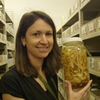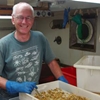General Description
Carapace of both sexes almost circular, about 1.1 times as long as wide, with longitudinal grooves on anterior third, without sharp lateral margins or sulci. Antennae minute. Maxilliped 3 with inner distal angle of merus curved, carpus rounded; palp 2-articled. Claw (chela) deeper distally, fixed finger and dactylus each with irregular teeth in proximal half. Walking leg 4 articulated to body not dorsally to leg 3; dactyli simple. Up to 12 mm wide.
Biology
The round pea-shaped carapace gives the common name to this tiny crab that lives in the gut cavities of holothuroids (sea cucumbers), and in the ascidian (sea squirt) Herdmania momus. While the relationship has been viewed as symbiotic or commensal, the benefits for the partners are not clear. It is certainly true that the crab derives considerable protection from predation by living in a holothuroid gut and it is probable that it gets some nutrient from mucus and the food trapped by the host as well. Little is known of the behaviour or biology of this species, however, other species of pea crabs residing in sea cucumbers have been shown to adversely affect their hosts.
Habitat
In the gut cavities of sea cucumbers and sea squirts.
Soft substrates
Coastal shores
Distribution guide
Southern temperate oceans, including south-eastern Australia.
Species Group
Depth
Shore (0-1 m)
Shallow (1-30 m)
Water Column
Max Size
12 mm
Diet
Organic matter
Harmful
Not harmful but a nip from large claws could be painful
Commercial Species
No
Global Dispersal
Recorded in Australia
Conservation Status
- DSE Advisory List : Not listed
- EPBC Act 1999 : Not listed
- IUCN Red List : Not listed







